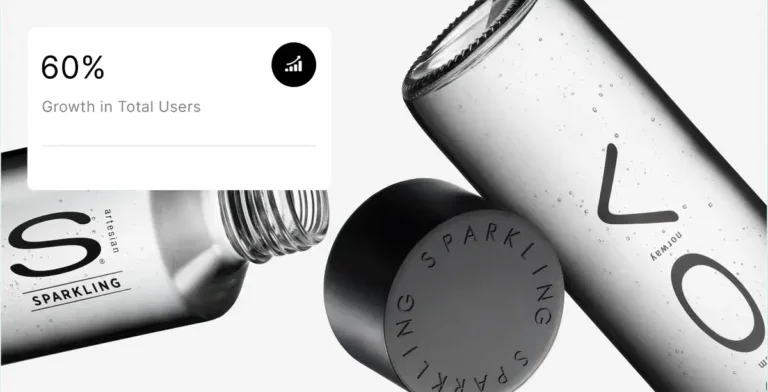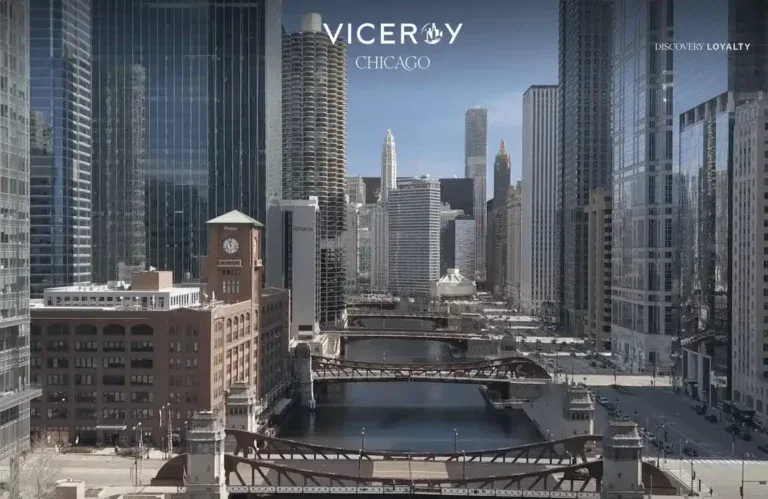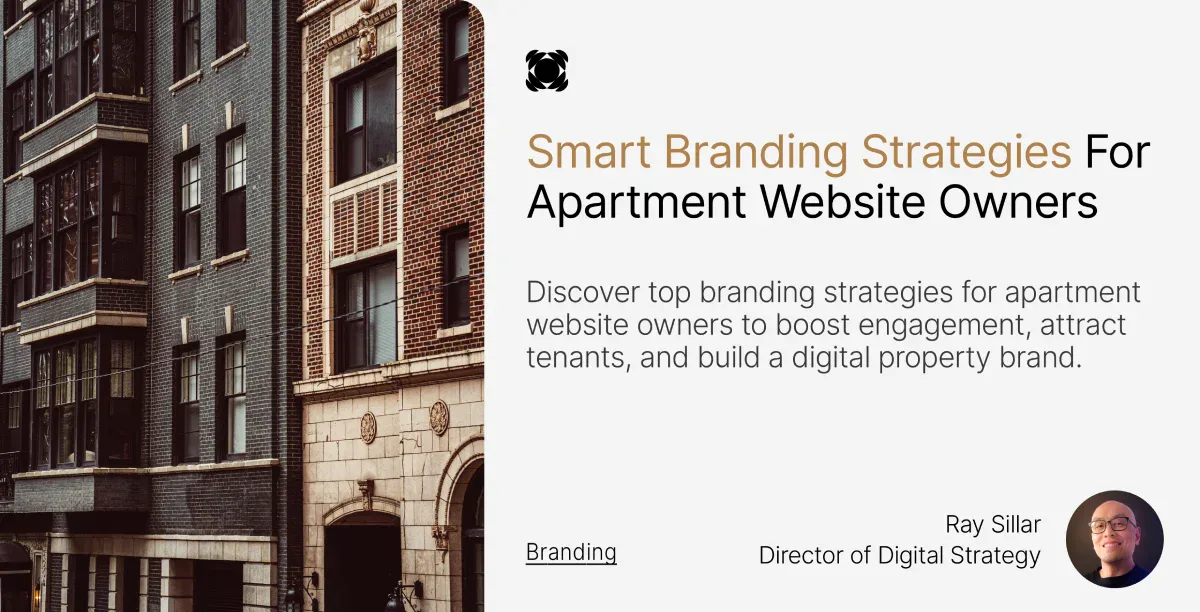60% of companies reported that being consistent in branding added 20% more growth to their brand.
Learning effective branding strategies for apartment website owners is as important as ever, as renters start their home search online.
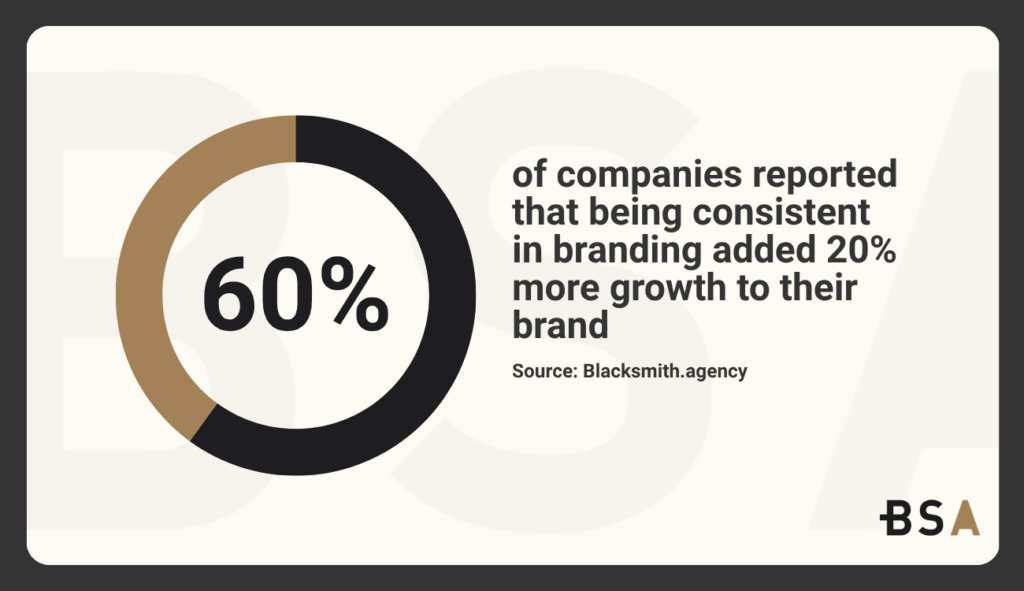
Modern apartment hunters are tech-savvy.
Research shows 84% use search engines while searching for homes, and almost 80% browse at least three websites before selecting communities to visit. Your digital presence creates that vital first impression for future residents.
Competition in this market remains fierce. The U.S. market saw 440,000 new apartment units last year, with 900,000 more under development. Strategic apartment marketing has evolved from a luxury to a necessity.
Visual content proves remarkably effective. People remember 65% of visual information after three days, while they retain only 10% of text-only content.
This piece will show you proven branding strategies for apartment website owners that will turn your apartment website into a marketing powerhouse that attracts qualified prospects and minimizes expensive vacancies.
Trying to improve your apartment website’s reach but don’t know where to start? Let us help.
Implement These Strong Branding Strategies For Your Apartment Website
Your apartment website’s visual identity is like a digital handshake between your property and future residents. A signature color increases brand recognition by up to 80%.
This makes consistent visual branding a powerful tool in your apartment marketing arsenal.
1. Use consistent colors and fonts
Colors do more than just look good; they shape how prospects notice your property. Each shade triggers specific emotions and psychological responses.
Blue creates trust and dependability, which explains why it’s the most commonly used color in logo design. Green brings thoughts of peace and nature, black represents luxury, and orange adds fun and playfulness.
Pick 2-3 complementary colors that show your community’s personality. This limit might seem tight, but it helps clarify your brand message.
Sophisticated properties might work best with a monochromatic scheme and metallic touches. Vibrant communities could benefit from bolder color combinations that match their energy.
Typography shapes visitor impressions just as much. Fonts come in several categories, each telling its own story:
- Serif fonts (with small “feet”): are traditional, respectable, and reliable.
- Sans-serif fonts: clean, modern, and approachable.
- Script fonts: elegant, creative, personal.
- Display fonts: unique, expressive, and attention-grabbing.
Pick no more than two fonts that work well together.
One for headlines and another for body text. Readability should be your top priority, especially since more apartment seekers now use mobile devices.
2. Design a logo that reflects your community
Your logo is the lifeblood of your visual identity. The best apartment logos share common traits: they’re simple, memorable, and connected to your community’s values.
Simple logos stand the test of time. Think about how your logo will look on everything from tiny phone screens to large property signs. Start by testing your design in black and white. The structure matters more than color at first.
Add visual elements that showcase one key aspect of your community. You might highlight an architectural detail, natural surroundings, or a unique amenity that sets you apart.
Stay away from generic clip art or stock images that don’t capture your property’s character.
After finalizing your logo, create a brand style guide with color codes, size requirements, and usage rules. This guide will give you consistency across all marketing materials, from social posts to printed brochures.
3. Choose imagery that matches your brand’s tone.
Website images tell powerful stories about life at your property.
People remember 65% of visual information after three days. This makes image selection vital for lasting impressions.
Neighborhood and lifestyle photos should truly represent your location. Skip generic cityscapes with famous buildings from other places.
So choose images that capture your local community’s real personality.
Images with people should follow fair housing rules by showing diversity in age, gender, race, and family status. This approach meets legal requirements and helps prospects imagine themselves living in your community.

Work your brand colors into images through props, accessories, or natural elements.
To name just one example, properties using teal might pick photos with teal accents. This subtle approach creates visual harmony throughout your website and builds brand recognition.
4. Optimize Your Website for Branding and Performance
A beautiful apartment website won’t help if prospects can’t use it well.
Your website’s technical performance is a vital part of turning visitors into residents and making your property visible in searches.
5. Ensure fast page load speed
Speed makes more difference than you think. Over 53% of mobile users leave websites that take more than three seconds to load.
Apartment websites face a double problem when they load slowly. Potential renters leave before they see your property.
Google also ranks slow sites lower in searches, which makes it harder for future prospects to find you. These two issues lead to more vacant units and higher marketing costs.
You can check your current speed with Google PageSpeed Insights or GTMetrix. If your score needs work, here are the quickest ways to improve:
- Use WebP format to compress images while keeping quality high.
- Set up browser caching so returning visitors get faster load times.
- Cut down on redirects that slow things down.
- Clean up your code and reduce external scripts.
6. Make your site mobile-friendly
Mobile devices now account for over 61% of apartment website visits. This move to smaller screens changes how prospects look at your property details.
Google now looks at mobile versions first when ranking sites. Websites that don’t work well on smartphones don’t get much organic traffic, regardless of their desktop experience.
For example, mobile-friendly test helps you check how ready your site is.
Here’s what matters most for mobile:
Your design should adjust automatically to fit any screen size. Fixed layouts that need zooming and sideways scrolling drive users away quickly.
Important details need to be easy to find. Floor plans, prices, availability, and contact forms must work perfectly on mobile devices. Virtual tours and 3D floor plans should work without needing special plugins like Flash.
Bigger fonts and well-spaced buttons prevent wrong clicks and make navigation easier.
Explore how we increased Coaching Right Now’s returning users by 21% with a new branding strategy in our recent case study.
7. Use SEO best practices for apartment marketing
Good SEO helps your property show up when renters search locally for apartments.
Start by setting up your Google Business Profile (GBP). This free tool helps people find you in local searches and on Google Maps. Keep your name, address, and phone number consistent, pick the right business category, and add quality property photos.
Each page should target different keywords instead of using the same terms everywhere.
Use H1, H2, and H3 headings to organize your content. You can use efficient SEO tools like Smart SEO Highlighter to identify headings properly, find page-level issues, and improve them. Your content and page headings should make sense to readers and search engines.
Write about your neighborhood to show you know the area well. Pages about nearby attractions, restaurants, parks, and transport options help attract renters and build authority for local searches.
Add descriptive alt text to every image, naturally working in relevant keywords. This helps both accessibility and search engines understand your pictures.
Technical optimization helps your branding work better by ensuring prospects can find and use all your apartment marketing materials.
8. Create a Seamless User Experience
Your apartment website’s user experience determines its success or failure.
Prospects make snap judgments about your property within 50 milliseconds of viewing your site. Smooth navigation becomes crucial when turning visitors into residents.
9. Simplify navigation and layout
Your website’s architecture shapes how prospects interact with your content. Quick access demands floor plans, photos, and amenities’ placement on the left side of your navigation menu.
The main menu should not exceed seven links. You might want to move resident-specific information to a secondary menu at the bottom of your page.
Creative visuals highlighting top amenities should take center stage on your home page to showcase your property’s unique features. Your layout should direct visitors to those vital internal pages they seek most.

A clean, uncluttered design lets prospects quickly find information without feeling swamped.
This approach improves user satisfaction and boosts SEO performance.
Lower bounce rates result as visitors spend more time on your site.
10. Add clear calls-to-action (CTAs)
Strategic CTAs guide prospects toward conversion points throughout your apartment marketing experience.
Studies reveal that customized CTAs outperform simple ones by 202%.
Buttons should pop using contrasting colors, bold text, uppercase letters, and subtle shadows.
Action-oriented language works better than generic phrases.
- “Schedule Your Tour Today” instead of “Contact Us”
- “Secure Your Spot Today” rather than “Apply Now”
- “Find Your Perfect Layout” versus “View Floor Plans”
CTAs work best where prospects make decisions – next to floor plan details, under virtual tours, or at the bottom of amenity pages.
Mobile users need thumb-friendly, easily tappable buttons.
11. Use interactive tools like virtual tours
Interactive elements turn passive browsing into active participation. Virtual tours create hundreds times more viewer engagement than standard 2D imagery. Future tenants can explore your property anytime, from anywhere.
Interactive property maps can also help renters picture their community layout, filter available units, and see pricing based on preferred move-in date and lease length.
Prospects can switch between map, floor plan, and unit views. This creates an uninterrupted shopping experience that builds confidence in their decision.
These interactive features work best at the floor plan level on your website. Smart placement helps prospects self-qualify, spend more time with your content, and make faster, more confident leasing decisions.
12. Use content to tell your brand story
Quality content drives leasing decisions for potential residents, not just beautiful designs and technical features.
Content marketing gives your apartment website a personality that converts browsers into tenants.
13. Add a blog with community updates
Companies that blog receive 55% more website visitors than those that do not. Your apartment blog works as both a marketing tool and a community resource. It builds credibility with prospects and search engines.
Your blog should feature hyperlocal content that shows life in and around your property. Write about nearby seasonal activities, new local businesses, community events, and resident spotlights.
This neighborhood-focused content helps prospects imagine themselves living there.
It also improves your search rankings for location-based queries.
Your blog becomes a storytelling platform that paints a picture of community life. Event recaps demonstrate what makes your property unique.
Posts about local attractions showcase your location’s benefits. This content strategy works because it answers a key question renters ask: “What would my life be like if I lived here?”
14. Include resident testimonials and reviews
Authentic resident experiences build credibility quickly.
A remarkable 71% of renters check ratings and reviews first when searching for a community. Strategic placement of testimonials across your website creates powerful social proof that traditional marketing can’t match.
Testimonials work best when placed next to relevant content. A review about your pool belongs next to amenities photos. Comments about responsive maintenance fit near service descriptions. This approach reinforces specific selling points through real resident experiences.
Video testimonials create stronger connections as well. These visual stories make your community more relatable and help prospects see themselves as residents.
15. Highlight local attractions and lifestyle
Your apartment represents more than just a living space; it’s part of a neighborhood. Local business and event posts show prospects that your property belongs to a thriving community worth calling home.
Neighborhood guides should feature resident-recommended shops, restaurants, parks, and transportation options. This content helps prospects, boosts SEO for local searches, and positions your property as part of a desirable area.
Prospects choose a lifestyle, not just an apartment. Content that showcases both your property and the surrounding neighborhood creates that vital emotional connection.
Learn how we increased bulbs’ new users by 22.6% with a new branding strategy in our latest case study.
16. Capture and Convert Leads with Smart Tools
You can convert website visitors into qualified leads easily with specialized digital tools that streamline the leasing process. The right lead capture technology turns casual browsers into serious prospects.
Use lead forms and chatbots
Chatbots work on your website 24/7 and answer prospect questions instantly. These AI-powered assistants typically respond in under 3 seconds per query. This creates opportunities for engagement that might otherwise slip away.
Properties using chatbots allow their staff to focus on complex problems 64% more effectively.
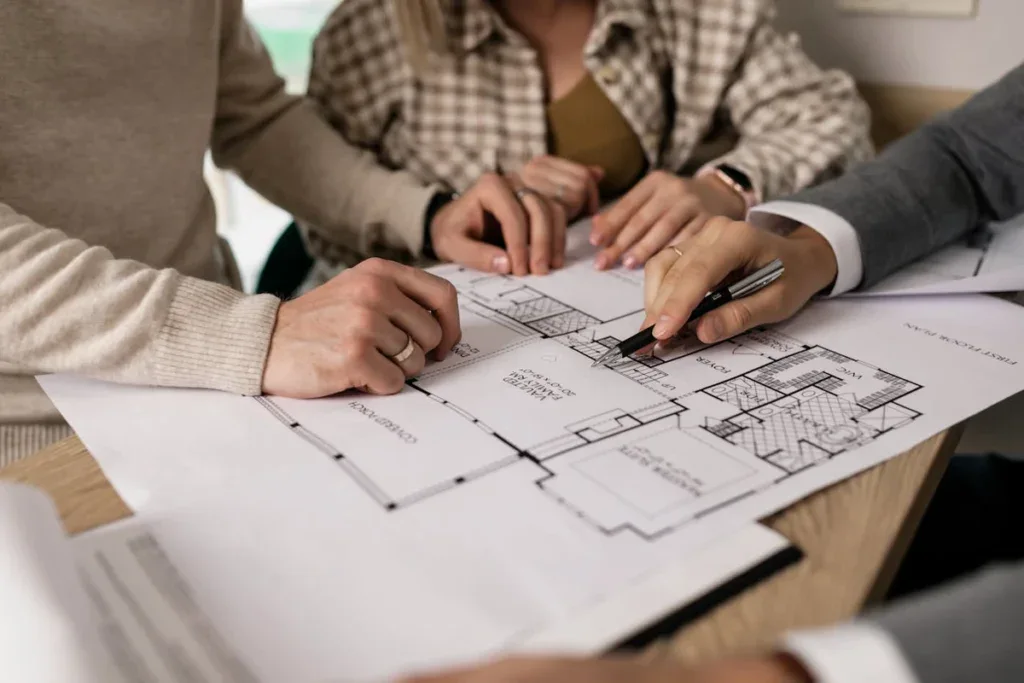
Multifamily chatbots create a personal experience for potential tenants through natural conversations that feel human. They collect essential information like contact details, budget parameters, and unit priorities automatically.
The leads are qualified based on predefined criteria before your leasing team receives them.
Offer downloadable brochures or floor plans
Contact information becomes available when you provide valuable resources in exchange.
Prospects become warm, ready-to-involve contacts when they submit their property details for information access.
Floor plans and detailed community information help prospects feel confident about moving forward.
Unlike traditional forms that create waiting time, immediate access to these materials gives prospects what they need right away. Your website traffic automatically turns into qualified leads around the clock.
Track user behavior to improve conversions
Website visitor interactions provide valuable insights for optimization. Behavior analytics tools track mouse movements, clicking patterns, and scrolling habits systematically. This helps identify potential bottlenecks.
Heatmaps reveal the most frequently clicked areas, while session recordings capture the exact user experience. This visual information helps to find areas where prospects face difficulties or leave their search.
Lead-to-lease conversion metrics calculate marketing success through a simple formula:
Marketing Success = (Number of Signed Leases / Total Leads Generated) x 100
Regular analysis of these numbers enables evidence-based improvements that boost marketing ROI and occupancy rates.
Upgrade Your Apartment Website Branding With Blacksmith
A great apartment website does way more than just look pretty online. Your website welcomes potential residents and needs to build trust, highlight what makes your community special, and turn visitors into residents.
The strategies in this piece create a complete marketing system that brings in quality prospects and keeps units filled.
By far, the strategy that takes the longest to work on but has the biggest impact when correctly done is branding.
But working on your apartment website SEO is not a small project; it’s a project that might take weeks, if not months, to see any sort of improvement. This is time you could use on other aspects of your business, including strategies in this article.
So what now?
That’s where we come in. Blacksmith is a professional branding agency with a group of branding experts ready to create the ideal custom strategy for your apartment website. From web design to landing page optimization, your website’s branding will be worked on relentlessly until conversions come in.
Still unsure if getting a custom branding strategy is what your apartment website needs?
Don’t worry, click here to schedule a call with us and we’ll provide you with a free brand and website audit. This way we can show you in what areas your website needs improvement and how we can fix and help your website get the conversions it deserves.

